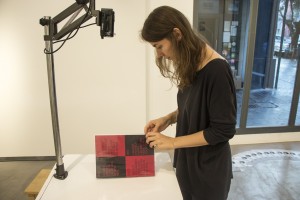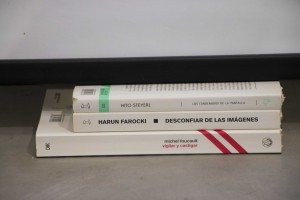With the audiovisual device put in work during the exhibition, she staged Nicoleta Moise, through a live projection, the use made of the people present her book. How to turn the pages, stopping at certain images or texts; but also how hands touching the book will move from its location, slide or tilt, reframing on the projection screen images manipulated book.



This notion of reframing is essential throughout the exhibition. About the original photographs, Moise has not stopped performing this operation for her book, but in the exhibition where it is evidenced more visual (and procedural) clearly. Any use of a given file is greater or lesser extent, a specific reframing. Reframing means “new meaning”. Moise put into dialogue the images of the past and reframing that is applied from the present, creating new meanings that reveal previously unknown aspects of the old violence (the discipline of bodies, but also the representation of “violence Western epistemic” he would say Gayatri Spivak). And it puts well in evidence in the specific arrangement of each reframing we can find pragmatic pathways for reappropriations, recreations and reinventions of any file.


As mentioned in the text of contextualization of this series of exhibitions, “Files in Fugue” are grouped the latest works by three emerging artists, three girls and “peripheral” women (Nicoleta Moise and Paula Onet born in Romania, Lamia Mohacht in Morocco) that address from diverse perspectives and temporalities certain possibilities of subversion and reformulation of specific and very close to their own experience visual files.
Now, what we meant the jargons of “peripheral” (with quotes) these young artists? This was the question he asked me to prepare together Nicoleta Moise filmed interview now published. This part of the text has been written, then, as an answer to that question -so pertinente- young Romanian artist. And it is that an exhibition, here and now, we are interested above all as collective experience and as a dialogic process.
As evident the work of the Serbian feminist artist Tania Ostojic, “Women Europe Service (the former communist countries) are considered and accepted in the European Union as a also service women” (Walter Mignolo). What, moreover, the relationship of Moroccan women regarding the Spanish “Metropolis”? a history and experience of colonialism, external and internal, is still alive in that relationship.
Not otherwise irrelevant to remember that the Romanian community and Moroccan are the most numerous of migrant communities rooted in Spain. While it is true that more and more the Spanish state is seeing relegated to subordinate the global South, regarding the Romanian woman or Moroccan continues to exercise the role of “center” place of exclusion and subordination. the gender issue must be added to the geopolitical issue. As Romanian and Moroccan women, these artists and their works are in a duplicate subordination. Activate the file from this “peripheral” double position challenges the very notion of “center” (art, power, gender, institutions) and processes subalternization, linking “Files in Fugue” with decolonial aesthetic.



References:
Spivak, Gayatri Chakravorty (2010), Crítica de la razón postcolonial. Madrid. Akal.
Mignolo, Walter D. (2015), “Aiesthesis descolonial”, en Sentir y pensar la descolonialidad (Antología, 1999-2014). Barcelona. CIDOB.

